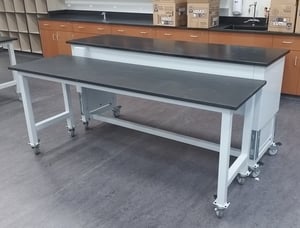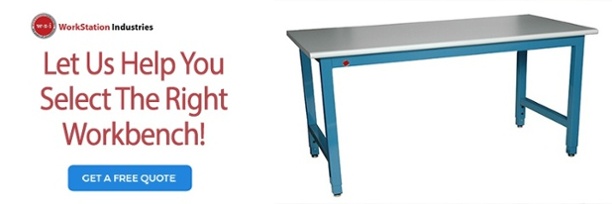Like the steady foundation of feet supporting humans and animals, adjustable workbench feet often serve as the unsung heroes of industrial workspaces, ensuring balance and flexibility in the face of uneven surfaces.
Workbench feet, which attach to the bottom of a workbench, allow workers to adjust the height and level of the workspace. They are an important component to the design of an adjustable workbench. However, you may require additional features on your workbench to adequately meet your workers’ needs.
A Balancing Act: Adjustable Workbench Feet
Adjustable workbench feet are commonly found in workshops, garages, manufacturing facilities, and other industrial settings where stability and versatility are crucial. They offer convenience and ease of use, allowing users to customize the workbench height and ensure a safe and comfortable working environment.
industrial settings where stability and versatility are crucial. They offer convenience and ease of use, allowing users to customize the workbench height and ensure a safe and comfortable working environment.
Adjustable leveling feet are components that are attached to the bottom of a workbench to provide stability and adaptability to different surfaces. They are designed so that a worker can more easily adjust the height or leveling of the workbench, especially on uneven surfaces.
Workbench feet are typically made of durable materials like metal or hard plastic and are attached to the legs or frame of the workbench. They often have threaded studs or screws that can be extended or retracted to modify the height of each individual foot. Some adjustable feet may also feature a swivel or pivoting mechanism, allowing for additional flexibility in leveling the workbench on uneven floors.
The main purpose of adjustable workbench feet is to compensate for irregularities in the floor surface, ensuring that the workbench remains stable and balanced. By adjusting the height of the individual feet, users can compensate for variations in the floor level, preventing wobbling or shaking of the workbench during use. This is particularly important when performing tasks that require precision or applying significant force on the workbench.
Making Your Adjustable Workbench Feet Mobile
You also have the option of turning your workbench feet into a mobile accessory. Casters can turn a workspace into mobile workstation furniture.
However, there are a few things to keep in mind when considering casters. Casters, which are placed at the end of the legs on a workbench, may only hold a few hundred pounds if bought online through an office supply site. That’s why it’s important to ensure the workstation you provide for your employees has casters that can support it.
Casters that have a weight load capacity of around 1,000 pounds when using all four casters are often more suitable in an industrial setting. Other features to look for include:
- Whether all four wheels lock
- If they swivel in place, whether when locked or unlocked
- Whether they are adjustable in height
Casters also come in a variety of sizes, from 1.25 inches to 4 inches, depending on the size of your workbench.
How Adjustable Legs Can Elongate Your Workbench
While adjustable workbench feet can elongate your workbench by a few inches, their main role is leveling a bench on uneven floors. If you’re instead looking for an option that can raise your workbench to standing-height, you’ll need to consider a workbench that features height adjustable legs.
An adjustable workbench allows employees to adjust the height of the workstation based on their personal comfort level. In today’s work environment, allowing workers to adjust the height of their workspaces is especially important since several studies have linked work environment to injuries like musculoskeletal disorders (MSD).
This ergonomically-friendly design is linked to better employee health, enhanced productivity and improved employee retention and recruiting.
There are four lift mechanism options for your industrial adjustable workbench:
- Slot adjustment: The worker must make adjustments by raising the work bench legs and removing bolts or spacers. This type of bench allows employees to adjust the height of the bench, but isn’t the most ergonomically-friendly option because it requires the worker to manually lift the bench.
- Hand crank: A hand crank adjustable height workbench is manual in design, but allows employees to rotate a hand crank to lift or lower the bench. A hand crank makes the process of lifting the workbench easier for workers, but if there are heavy tools, products or other objects on the bench, it may be difficult to raise and lower the worksurface.
- Hand crank with hydraulic features: When cranked, the hydraulic fluid in the cylinders force the shafts in the legs to elevate. This pressure that lowers or lifts the work surface makes the process easier, especially with heavy duty workbenches that hold heavy loads.
- Electric: An electric adjustable height workbench provides a high level of ergonomic support. An employee can easily lift or lower the surface with the push of a button. If there are heavy work tools on the bench, a bench with an electrical component will also require less physical effort to raise the bench than hand cranking the bench. Depending on the model, you may be able to preset positions for convenience as well.
When choosing a lift mechanism, you should take into consideration several factors like your facility’s needs, budget and level of ergonomic support you want to achieve. Each type of adjustable workbench above has pros and cons. For example, a hand crank adjustable bench may be more budget-friendly, but workers may have more difficulty lifting heavier items or machines. An electric adjustable height workbench can help with heavier objects, but this workbench must be located near an electrical source.
A Workbench That Supports Your Workers’ Needs
Adjustable workbench feet play a vital role in providing stability and adaptability to workbenches in industrial settings. These feet allow users to easily customize the height and leveling of the workbench, ensuring a safe and comfortable working environment.
While workbench feet can help meet any shortcomings of a standard bench, if your needs involve mobility, you may need add casters as an accessory. On the other hand, if you want a workbench that allows your workers to adjust the tabletop height based on their comfort and needs, you may need to explore the possibility of choosing a work table that has adjustable legs.
A quality industrial furniture company can help you weigh your options and work with you to design a workbench that will meet your business’s needs now and well into the future.


